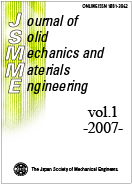Volume 1, Issue 6
Displaying 1-10 of 10 articles from this issue
- |<
- <
- 1
- >
- >|
Papers
-
2007Volume 1Issue 6 Pages 728-733
Published: 2007
Released on J-STAGE: June 29, 2007
Download PDF (1406K) -
2007Volume 1Issue 6 Pages 734-743
Published: 2007
Released on J-STAGE: June 29, 2007
Download PDF (4822K) -
2007Volume 1Issue 6 Pages 744-754
Published: 2007
Released on J-STAGE: June 29, 2007
Download PDF (1720K) -
2007Volume 1Issue 6 Pages 755-766
Published: 2007
Released on J-STAGE: June 29, 2007
Download PDF (1008K) -
2007Volume 1Issue 6 Pages 767-778
Published: 2007
Released on J-STAGE: June 29, 2007
Download PDF (755K) -
2007Volume 1Issue 6 Pages 779-786
Published: 2007
Released on J-STAGE: June 29, 2007
Download PDF (2268K) -
2007Volume 1Issue 6 Pages 787-795
Published: 2007
Released on J-STAGE: June 29, 2007
Download PDF (1374K) -
2007Volume 1Issue 6 Pages 796-805
Published: 2007
Released on J-STAGE: June 29, 2007
Download PDF (637K) -
2007Volume 1Issue 6 Pages 806-814
Published: 2007
Released on J-STAGE: June 29, 2007
Download PDF (1370K) -
2007Volume 1Issue 6 Pages 815-826
Published: 2007
Released on J-STAGE: June 29, 2007
Download PDF (637K)
- |<
- <
- 1
- >
- >|
